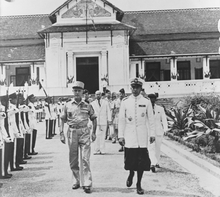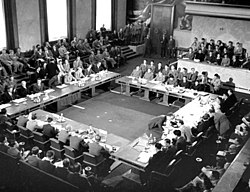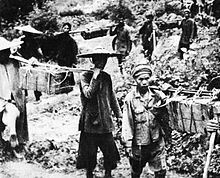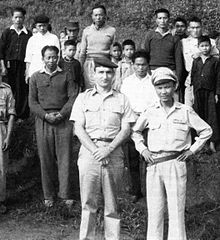History of Laos (1945–present)
Lao ministers took control of all government functions except foreign affairs and defence, although the almost total dependence of the economy on French aid made this new independence more apparent than real.The discrediting of the French and the failure of the Lao Issara government gave them their opportunity, because after 1949 the struggle against colonial rule could only be carried on from bases in Vietnam and with the support of the Vietnamese communists.The government remained weak and faction-ridden, and also increasingly corrupt as leading politicians found ways for themselves and their relatives to profit from the foreign money pouring into the country.Suvannaphūmā remained the leading non-communist politician and retained the confidence of the King, but right-wingers, led by Bunūm na Champāsak, opposed his policy of coalition and reconciliation with the Pathēt Lao.To get around the prohibitions of the Geneva agreements – which the United States had pledged to honour – the US Department of Defense in December 1955 established a disguised military mission in Vientiane called the Programs Evaluation Office (PEO).[2] Over the 1955-61 period, the PEO gradually supplanted the French military mission in providing equipment and training to the Royal Lao Army[2] and the anti-communist Hmong Tribe.[3] With regard to precedent, this was a decidedly modest claim - nonetheless, it represented a unilateral reinterpretation of the French map used by the Truong Gia Armistice Commission in the summer of 1954 to draw the DMZ, and, backed by force of arms, constituted nothing less than aggression.[3] These operations established a pattern of North Vietnamese forces leading the attack on a strong point, then falling back and letting the Pathet Lao remain in place once resistance to the advance had been broken.Suvannaphūmā was briefly arrested, but when the Americans refused support to the coup it collapsed, but the Pathēt Lao ministers left the capital and did not return, effectively ending the Coalition government.While the ethnic minorities who mainly populated the mountains of the Pathēt Lao areas suffered terribly as a result of the war, the majority of the Lao-Lum people in the Mekong Valley towns were little effected in a military sense.The influx of US personnel and money (an estimated $US500 million in US aid alone) produced an economic boom in the towns as service industries grew to meet the demands of the war and the large resident American civilian population.At its 1968 congress, the Front issued a 12-point program which made no mention of socialism, but called for a Government of National Union and free elections, and promised respect for Buddhism and the monarchy.The two sides in Laos had been in informal discussions since the previous July, and once their respective patrons had consented, they quickly signed a ceasefire and announced an Agreement on the Restoration of Peace and National Reconciliation.But press censorship was introduced in the name of "national unity," making it more difficult for non-communist forces to organise politically in response to the creeping Pathēt Lao takeover.In March 1975, confident that the US no longer had the wherewithal to intervene militarily in Indochina, the North Vietnamese began their final military offensive in South Vietnam, which by the end of April carried them to victory with the fall of Saigon.Suvannaphūmā, dreading further conflict and apparently trusting Suphānuvong's promises of a moderate policy, gave instructions that the Pathēt Lao were not to be resisted, and the US began to withdraw its diplomatic personnel.The party's French-educated intellectuals - President Souphanavong and education and propaganda minister Phumi Vongvichit - were more widely seen in public and were Politburo members, but not part of the inner group.Matters were made worse in 1979 when the Vietnamese invasion of Cambodia, and subsequent Sino-Vietnamese War, resulted in the Lao government being ordered by Vietnam to break off relations with China, ending another source of foreign assistance and trade.As well as economic grievances, the resistance was fuelled by resentment in urban areas over the government's restrictions on freedom of movement, tight censorship and curtailment of "decadent" western cultural activities such as cinema and nightclubs°.Lack of money and skilled personnel, plus an anti-Chinese political line directed by Vietnam, plus the Thai trade embargo, caused interruptions to vital services such as electricity.[11] The relationship cultivated in the revolutionary stage predisposed Laos to Indochinese solidarity in the reconstruction and "socialist construction" phases and all but ensured that relations or alignments with China and Thailand would be wary and potentially unfriendly.[11] The revolution was simply entering a new phase in 1975, and the LPRP leaders congratulated themselves upon ousting the imperialists and looked forward to advice and economic as well as military support, which was not available from any neighbour or counterrevolutionary state.[11] They formalised governmental contacts with their mentors at biannual meetings of the foreign ministers of Cambodia, Laos, and Vietnam starting in 1980 and through the joint Vietnam-Laos Cooperative Commission, which met annually to review progress of various projects.[11] In the LPRP, long-standing collaboration and consultation at the very top made special committees unnecessary, whereas in the LPA, the Vietnamese advisers, instructors, and troops on station constituted a pervasive, inescapable influence, even though they scrupulously avoided public exposure by sticking to their designated base areas.[11] The phrase "special relations" came into general use by both parties after 1976, and in July 1977, the signing of the 25-year Lao-Vietnamese Treaty of Friendship and Cooperation legitimised the stationing of Vietnamese army troops in Laos for its protection against hostile or counterrevolutionary neighbours.In the mid-1980s, the Vietnamese leaders, unnerved by the efforts of Mikhail Gorbachev to reach reconciliation with China, decided to reinforce their grip over Laos, even at the expense of their Soviet allies.[11] In 1992 the long-standing Vietnamese ambassador to Laos, a veteran of fourteen years' service, characterised the relationship as composed "d'amitié et de coopération multiforme entre les pays" (of friendship and diverse co-operation between the two countries).These included increasing corruption and nepotism (a traditional feature of Lao political life), as ideological commitment faded and self-interest arose to replace it as the major motivation for seeking and holding office.While long-term benefits were expected from these reforms, in the short term they produced inflation, unemployment among workers from the loss-making state sector, and resentment and insecurity among the urban population.The communist party retains a monopoly of political power, but leaves the operation of the economy to market forces, and does not interfere in the daily lives of the Lao people provided they do not challenge its rule.





History of LaosMuang SuaLan XangKingdom of VientianeKingdom of Luang PhrabangMuang PhuanKingdom of ChampasakLao rebellionHaw warsFranco-Siamese crisisFrench Protectorate of LaosFranco-Thai WarJapanese puppet stateFree Lao Movement (Lao Issara)Kingdom of LaosLaotian Civil WarNorth Vietnamese invasion of LaosAnti-Communist InsurgencyHistory of IsanPhetxarātViang ChanJapanesePrime MinisterLuang PhrabāngChampāsakde GaulleSuphānuvongVietnamHo Chi Minhstruggle against the FrenchSuvannaphūmāKaisôn PhomvihānThailandSavannakhētBangkokPrincipality of ChampāsakBunūm na ChampāsakFrench UnionPākxēNational AssemblySuvannarātPrime Minister of LaosLao-LumUnited StatesGreat BritainUnited NationsSoviet UnionFrench ArmyPhibunIndochinese Communist PartyHong KongCommunist InternationalMoscowFrench IndochinaHmong peopleLao-ThoengLao People's Revolutionary PartyPolitburoGeneva Conference (1954)General SalanPrince Sisavang Vatthanaeconomic boomDien Bien PhuPierre Mendès-FranceGenevaGeneva ConferenceKu VôravongKatay Don SasorithGeneva AccordsHouaphanPhongsālīEisenhowerJohn Foster DullesCentral Intelligence AgencyPhūmī VongvichitHo Chi Minh trailUS Agency for International AidXépônPhūmī NôsavanDemilitarised ZoneNorth VietnamSouth VietnamKong LeXam NuaKông LaeXam NeuaCambodiaJohn F. KennedyNikita KhrushchevViennaLuang NamthāPlain of JarsVietnam WarVang PaoList of military operations of the Laotian Civil War316th DivisionThai ArmyNorth Vietnamese ArmyMekongmassive bombing of communist positionsRichard NixonLon NolSihanoukvilleBuddhistsheart attackfall of SaigonKhmer Rougeentered Phnom Penhseizure of power in LaosLao People's Democratic Republicone-partycommunist stateKhamtai Siphandôncommunismcapitalist developmentorthodox MarxistsocialismcollectivisationSino-Vietnamese Warthe Crown PrinceNew Economic PolicyDeng XiaopingcontinuedVietnamese armyThongsouk SaysangkhiMarxism-Leninism